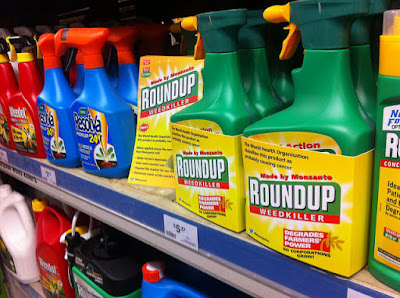 |
| Photo: Creative Commons |
The discovery that GM cotton plants which generate 'Bt' insecticide suffer from impaired ability to support the vital associations with soil fungi in their roots wasn't anticipated [1]. Increasingly, these same Bt crops are also being genetically engineered to tolerate glyphosate herbicide.
Just how Bt plants adversely influence the fungi in and around their roots is unexplained, but glyphosate's effects are highly predictable: fungi are plants and can be harmed by herbicides such as glyphosate due to the same toxic mechanism which kills the weeds. Indeed, a study by Argentinian scientists on grassland, typically treated with glyphosate in late summer to promote the growth of winter annuals, found reduced fungal spore viability and fungal root-colonisation.
In addition to direct effects on fungi, glyphosate has known indirect effects on the soil.
For example, before it became commercialised as a weed-killer, glyphosate was recognised for its antibiotic properties. It's presence in soil kills certain classes of bacteria leaving a potential space for pathogenic strains to thrive.
Also, the herbicide has powerful mineral-binding properties which render essential minerals unavailable to the life in the soil.
Add to this, the sudden input of decomposing plant matter which floods the soil with nutrients after glyphosate application and which stimulates the growth of certain sectors of soil life.
All of these will reduce the vital diversity of soil organisms needed for a healthy soil [2].
Glyphosate has serious effects on soil phosphates. Although the herbicidal chemical itself could be a source of phosphate on decomposition, this isn't in a form likely to interfere with the soil. However, glyphosate can compete with the phosphates already in the soil for mineral binding sites. Herbicide application leads to a sudden release of phosphates which are simply washed out of the soil and become a major pollutant of waterways.
OUR COMMENT
Longer term negative effects on plants from accumulated glyphosate sequestered in some soils may be inevitable, but no one's testing.
Sadly one of the reasons not to test is that the staple US food-chain now depends overwhelmingly on glyphosate-sprayed GM crops. No one dares to find them harmful.
To protect your environment's future, the most effective immediate action YOU can take is to demand non-GM fed poultry, meat and dairy from your supermarket. Ask your friends to do the same.
Background:
[1] FUNGI DON'T LIKE Bt CROPS - September 2016
[2] HEALTHY SOIL NEEDS A DIVERSITY OF LIFE - September 2016
SOURCES:
- Magdalena Druille, et al., 2013, Glyphosate reduces spore viability and root colonization of arbuscular mycorrhizal fungi, Applied soil Ecology 64
- The impact of glyphosate on soil health - The evidence to date, Soil Association 2016
- Laura Barrera, Scientists: Glyphosate contributes to phosphorus runoff in Lake Erie, No-Till Farmer 11.06.16
No comments:
Post a Comment
Thanks for your comment. All comments are moderated before they are published.